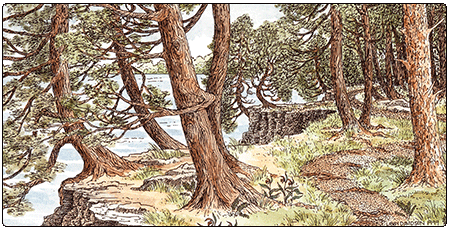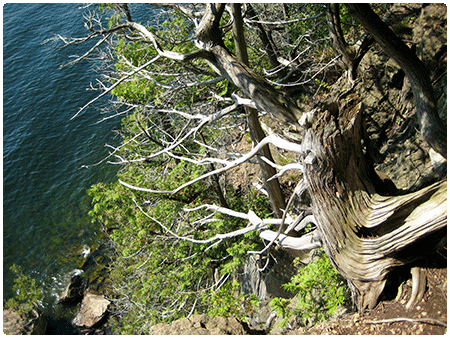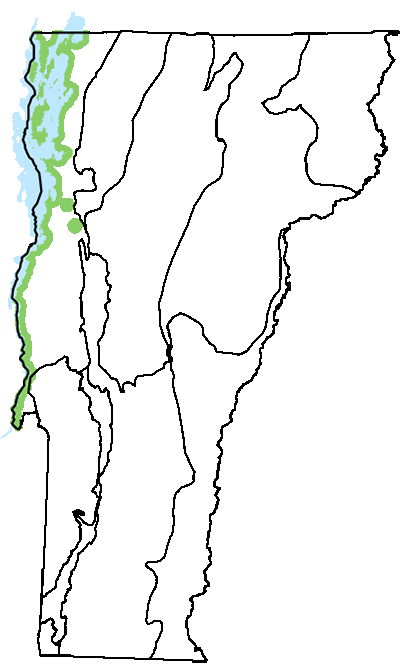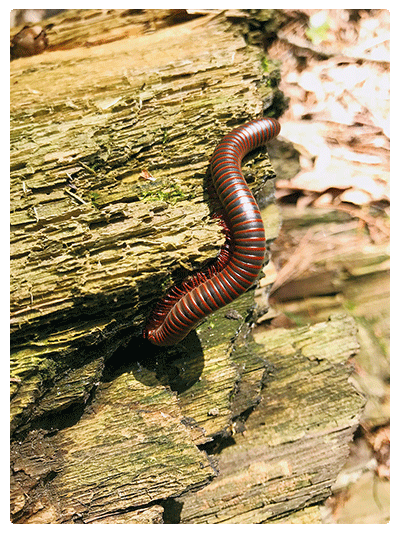Ecology and Physical Setting
The twisted and upswept northern white cedars that hug the clifftops along Lake Champlain make Limestone Bluff Cedar-Pine Forests one of Vermont’s most distinctive natural communities. Although the cedar canopy can be dense, filtered sunlight from the lakeside edge illuminates the forest floor. This community occurs on bluffs or outcrops of limestone, shale, or dolostone. It usually occupies a narrow band along the top of the bluff, although it may extend several hundred feet inland. Occasionally, these forests occur away from the lake as well, on calcareous clifftops or ridges.
Cedars on these bluffs grow very slowly and are rarely straight or tall. On headlands in Malletts Bay, cedars reach ages of 300 years or more. In similar communities on the Niagara Escarpment in Ontario, cedars exceeding 1,000 years in age have been documented. These very old, slow-growing trees can be surprisingly small—sometimes only a few inches in diameter.
Soils in Limestone Bluff Cedar-Pine Forests are very shallow to nearly absent and have a high organic content. Because this soil does not hold moisture well and because rainfall is naturally low in these places (less than 36 inches—low for Vermont), soils are very dry. The thin soils over calcareous bedrock, the warm and droughty summer conditions, and the exposure to winds off the lake are key environmental factors influencing these forests. Natural disturbances are driven by exposure to wind and water spray off the lake. Wind can topple shallow-rooted trees, sometimes even flattening several acres of forest. In winter, ice accumulation on branches from wind-whipped waves damages trees and contributes to their stunted, gnarled form.
Vegetation
Small, twisted trees of northern white cedar are dominant and provide dense shade along the edge of the cliff or bluff. Often the trees are no more than 20 feet tall. It is not uncommon to find stunted trees less than 15 feet tall, yet over 200 years old, with hollow centers, clinging to the clifftops. Red pine, white pine, hophornbeam, and hemlock are also common in varying amounts. Where there is dense shade, the understory is sparse and of low diversity, but openings can be quite diverse. Ebony sedge is a characteristic herb, forming a wispy carpet on the forest floor. Numerous rare plants grow in these forests, owing to calcium-rich bedrock and warm climate.
Wildlife Habitat
Limestone Bluff Cedar-Pine Forests are one of the few predominantly coniferous forest habitats along the shore of Lake Champlain, so they provide unusual wildlife habitat. White-tailed deer use these forests for cover and they also browse on cedar during the winter months. Yellow-rumped warbler and black-throated green warbler are much more common in northern coniferous and mixed forests, but also occur in Limestone Bluff Cedar-Pine Forests. The rocky terrain and ledges, adjacent cliffs, and dense cover in cedar bluffs provide denning habitat for bobcats, even in the densely populated areas of the Champlain Valley. Land snails and millipedes, such as the American giant millipede, are commonly found on the moss-covered limestone and dolostone of cedar bluffs. The rare five-lined skink and eastern ratsnake may use the exposed rock outcrops and cliff tops for basking.
Successional Trends
This community replaces itself almost immediately when disturbed. Cedar regenerates well on open bedrock, whether the opening is natural or caused by humans. Deer browse can have a significant impact on cedar regeneration and rare plants.
Related Communities
- Dry Oak-Maple Limestone Forest can be found adjacent to Limestone Bluff Cedar Pine Forest, or away from the lake edge. Slightly deeper soil pockets and an abundance of hardwoods differentiate the two.
- Temperate Calcareous Outcrop: Small openings of Temperate Calcareous Outcrop can occur within Limestone Bluff Cedar-Pine Forest. The two communities share many species in common.
Conservation Status and Management Considerations
This is a rare community in Vermont, and because it most commonly occurs on lake bluffs it is vulnerable to clearing for views and lake access. It is highly susceptible to encroachment by non-native invasive species. Fortunately, some very fine examples of this community are protected on public and private conservation lands. Owners of bluffs where this community occurs can aid in its protection by minimizing the cutting of cedar, maintaining a natural forested buffer to the community, and removing invasive species such as buckthorn and honeysuckle.
Distribution/Abundance
Rare statewide. Most common on calcareous bluffs along Lake Champlain, but there are also small examples away from the immediate lakeshore. This community occurs on the New York side of Lake Champlain as well, and likely into Québec. Very similar communities are found along the Niagara Escarpment in Ontario.
Characteristic Plants
Trees
Abundant Species
Northern white cedar – Thuja occidentalis
Occasional to Locally Abundant Species
White pine – Pinus strobus
Red pine – Pinus resinosa
Eastern hemlock – Tsuga canadensis
Hophornbeam – Ostrya virginiana
Red oak – Quercus rubra
Shagbark hickory – Carya ovata
White ash – Fraxinus americana
Sugar maple – Acer saccharum
Basswood – Tilia americana
Eastern red cedar – Juniperus virginiana
Shrubs
Snowberry – Symphoricarpos albus
Bush-honeysuckle – Diervilla lonicera
Poison ivy – Toxicodendron radicans
Glaucous honeysuckle – Lonicera dioica
Herbs
Abundant Species
Ebony sedge – Carex eburnea
Harebell – Campanula rotundifolia
Wild columbine – Aquilegia canadensis
Rock polypody – Polypodium virginianum
Occasional to Locally Abundant Species
Intermediate wood fern – Dryopteris intermedia
Marginal wood fern – Dryopteris marginalis
Bulblet fern – Cystopteris bulbifera
Herb Robert – Geranium robertianum
Pedunculate sedge – Carex pedunculata
Four-leaved milkweed – Asclepias quadrifolia
Walking fern – Asplenium rhizophyllum
Bryophytes
Moss – Anomodon rostratus
Moss – Anomodon attenuatus
Common fern moss – Thuidium delicatulum
Moss – Abietinella abietina
Moss – Rhytidium rugosum
Non-native Plants
Canada bluegrass – Poa compressa
Invasive Non-native Plants
Morrow’s honeysuckle – Lonicera morrowii
Tatarian honeysuckle – Lonicera tatarica
Japanese barberry – Berberis thunbergii
Common buckthorn – Rhamnus cathartica
Oriental bittersweet – Celastrus orbiculatus
Well-lettuce – Mycelis muralis
Rare and Uncommon Plants
Ram’s head lady’s slipper – Cypripedium arietinum
Purple clematis – Clematis occidentalis
Yellow oak – Quercus muehlenbergii
Canada buffaloberry – Shepherdia canadensis
American bittersweet – Celastrus scandens
Graham’s rockcress – Boechera grahamii
Harsh sunflower – Helianthus strumosus
Golden corydalis – Corydalis aurea

Rock whitlow-grass – Draba arabisans
Yellow pimpernel – Taenidia integerrima
Small skullcap – Scutellaria parvula var. parvula
Stiff gentian – Gentianella quinquefolia
Nodding stickseed – Hackelia deflexa
Longleaf bluet – Houstonia longifolia
Seneca snakeroot – Polygala senega
Associated Animals
Southern flying squirrel – Glaucomys volans
Eastern gray squirrel – Sciurus carolinensis
White-tailed deer – Odocoileus virginianus
Bobcat – Lynx rufus
Yellow-rumped warbler – Setophaga coronata
Eastern wood pewee – Contopus virens
House wren – Troglodytes aedon
Great crested flycatcher – Myiarchus crinitus
American giant millipede – Narceus americanus
Rare and Uncommon Animals
Common five-lined skink – Plestiodon fasciatus
Eastern ratsnake – Pantherophis alleghaniensis
Osprey – Pandion haliaetus
Columbine duskywing – Erynnis lucilius
Places to Visit
Kingsland Bay State Park, Ferrisburgh, Vermont Department of Forests, Parks and Recreation (VDFPR)
Eagle Mountain, Milton, Lake Champlain Land Trust
Red Rocks Park, South Burlington
Niquette Bay State Park, Colchester, VDFPR
